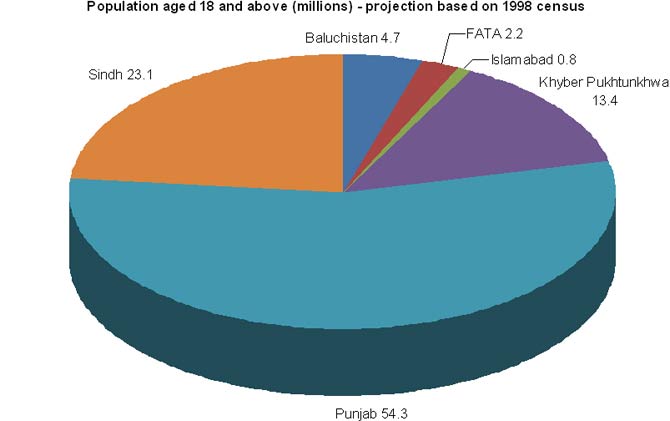
An analysis of the new voter list issued by Election Commission of Pakistan late last month shows that up to 15 million Pakistanis of voting age may have been left out of the rolls. As compared to the rolls used for the last general election, the number of voters has declined substantially in most districts of Sindh and Balochistan.
KARACHI, Aug 2: As many as 15 million Pakistanis of voting age may have been left out of the final electoral rolls released by the Election Commission of Pakistan (ECP) on July 31.
Based on the 1998 census, Pakistan’s current population should be around 190 million people today. About 51 per cent of the population is, according to the census report, aged 18 and above. That implies an estimated 98 million Pakistanis are now eligible to vote.
But only about 84 million Pakistanis are included in the recently released final electoral rolls (FER-2012), leaving one in seven people without the right to vote. The Free and Fair Election Network estimates the gap to be even higher, at 20 million voters.
The last census in the country was conducted during 1998 in a period of relative peace by the Population Census Organisation of Pakistan.
That massive exercise, which was supported by federal and provincial governments, the army, and other law-enforcement agencies generated data that is generally considered transparent and used by all national and international organisations for planning and resource distribution.
The ECP has also confirmed that it will be delimitating constituencies for the upcoming elections based on the 1998 census.

But the disparity between the 1998 numbers and the FER-2012 doesn’t end at the national level. If we take a closer look at the four provinces and their ‘registered to vote’ versus ‘eligible to vote’ populations, one out of 10 adults has not been registered to vote in Khyber Pakhtunkhwa and Punjab, one in five in Sindh, and one in four in Fata and Balochistan.

The FER-2012 appears to have been developed on the basis of the FER-2007, with the ECP and Nadra carrying out a major exercise to verify and augment the previous list. Interestingly, major districts in south Punjab including Multan, Bahawalpur, Bahawalnagar, Dera Ghazi Khan, Rahim Yar Khan and Vehari have seen substantial reductions in the number of registered voters compared to the 2007 list, while most major districts in central and north Punjab, including Lahore, Faisalabad, Rawalpindi, Sheikhupura, Hafizabad, Jhelum, Khushab, Mandi Bahauddin, Narowal, etc., have seen a substantial increase in the number of registered voters for the FER-2012.
• Voter lists have been made available at district-level Election Commission of Pakistan officesAs expected, women remain badly under-represented in all areas of the country. Based on population figures, around half of all adult females in Balochistan and Fata seem to have been left out of the FER-2012, one-third in Sindh and one-fourth in Khyber Pakhtunkhwa and Punjab.• Plans to distribute them at union-council level are under consideration
• Voters can also verify their registration information by sending their CNIC in an SMS to 8300
• Voters who are not yet registered, or whose entries are not correct, can get their information added or corrected through the ECP until the election schedule is announced.
The reasons for fewer registered voters in Balochistan, Sindh and Fata might include poor law and order and difficult post-flood conditions in 2010 and 2011 in these regions. But other factors could be increasing alienation amongst these populations and a rising disillusionment with the national political process.
Going to Nadra to augment the voter’s list may have been the right thing to do. But the Election Commission of Pakistan also needs to find ways to reverse what could be growing alienation among the people of Balochistan, Sindh, Fata and most of rural Pakistan.
Number of voters falls in most Sindh and Balochistan districts: Millions of voters may be unregistered because of lack of CNICs

If the latest electoral rolls are used in their current form, there are parts of the country where fewer Pakistanis will be able to vote in the upcoming polls than in 2007.
The total number of voters nationally, according to the latest list released by the Election Commission on July 31, stands at 84.4 million, compared to 81.2 million in 2007. This is a suspiciously low growth rate given the rapidly expanding Pakistani population — an average of less than one per cent a year.
But at least it represents growth. In Sindh and Balochistan, though, the numbers have declined dramatically, by 7 per cent and 22 per cent, respectively. [Read more]
Fewer female voters in North Waziristan

Because of the influence and pressure exerted by extremists and some religious elements, the number of registered women voters has significantly dropped in North Waziristan Agency, whereas Kurram Agency has the highest percentage of female voters among all the tribal agencies.
According to the new computerised voter lists released recently by the election commission, there are only 10,863 women among the 156,591 registered voters in North Waziristan. [Read more]













































